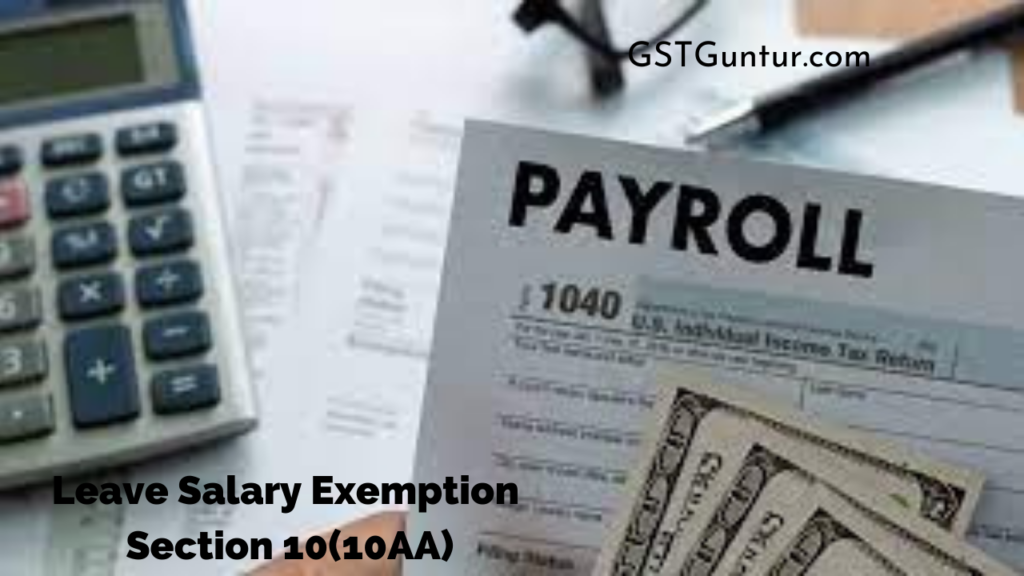Leave Salary Exemption Section 10(10AA): The Income Tax Act, 1961 u/s 10A vide its clause (10AA) renders for income tax exemption from leave encashment or leave Salary earned at the time of retirement, resignation or otherwise termination of employment. In many organisations, employees are allowed to take leave during their service time by the management. The employer is provided leaves of many types throughout the employment period, for example, Sick leave, Earned leave, unplanned Leave, Floating Leave, etc. On the other hand, earned leaves can be stored and moved forth to subsequent years. Using these leaves is not always feasible for the employees; therefore, the employees may encash these leaves and receive a salary for the number of days sanctioned to take leaves. The number of leaves permitted to be taken and the leave encashment differs from company to company procedures. An employee can initiate leave encashment while still working and at the time of retirement or superannuation, or resignation.
- Tax on Leave Encashment
- Leave Salary Exemption [Sec. 10(10AA)]
- FAQ’s on Leave Salary Exemption Section 10(10AA)
Tax on Leave Encashment
Under section 17(1)(va), if payment obtained by an employee in respect of any leave period that he does not avail from the employer, is liable to tax as ‘Salary’ income. Moreover, under section 10(10AA) of the Taxation Laws Act, 1984, an amendment was made to clarify that the exemption from leave encashment shall only be permitted where the employee takes the amount on his retirement or superannuation otherwise. Therefore, if an individual is applying for a large number of leaves, then the Salary earned will be quite high for leave encashment. This is particularly valid for government employees. Given are some conditions exercised when considering a tax on leave encashment:
- Encashing one’s leave while still serving in the company or government office, that particular amount is subjected to tax without exemption.
- Government employees are not responsible for paying any tax on leave encashment income at the time of resignation or superannuation.
- Income obtained by the private-sector employees as leave encashment is assessable as ‘Income from Salary’. However, certain exemptions apply to this income. After permitting the exemption, the outstanding amount will be calculated to the regular income and taxed as per the IT slabs.
- Employees from the private sector can get an exemption on leave encashment income u/s 10(10AA).
Leave Salary Exemption [Sec. 10(10AA)]
If an employee receives leave salary encashment while in employment, it is fully taxable in the employee’s hands. If leave encashment obtained at the employee’s termination time, then it is fully accessible. While if leave encashment is obtained in case of superannuation, retirement or resignation, then the exemption is available under the following conditions:
- In the case of Central Government or State government employees (excluding employees of a statutory corporation or local authority), leave salary encashment is fully exempted
- In the case of any other employee, the least of the following is exempt:
- The actual amount received
- 3,00,000 Maximum Limit
- The Average Salary of 10 months
Average Salary x leaves at an employee’s credit. If an employee has accumulated the number of leaves in a year, the organisation will consider only 30 days of leave per year for the encashment process. According to it, the total number of paid leaves will be calculated collectively during the retirement or resignation, and then encashment will be processed further. If the person has not employed all the paid leaves that estimates for 45 days, the company will still consider 30 days of paid leave for encashment at the time of resignation or retirement.
Average Salary = Average of Salary drawn in the last ten months immediately preceding the date of retirement.
Here basic pay, dearness allowance, retirement benefits and percentage-wise fixed commission on turnover are included in the Salary.
- If an employee receives leave encashment from more than one employer in the same preceding year or different preceding years, the maximum aggregate amount exempt from tax on leave salary cannot exceed Rs 3,00,000.
- If the employee had received leave encashment in any one or earlier PY and had availed of the exemption in respect of such amount, then the limit stipulated above shall be deducted by the amount of exemption availed earlier.
FAQ’s on Leave Salary Exemption Section 10(10AA)
Question 1.
State the exemption from leave salary in case of contract employees?
Answer:
Though employer-employee relations may subsist in the case of contractual work, the closing of such a contract amounts to the end of employment, which cannot be balanced with resignation or retirement. Therefore no exemption from leave encashment collected from the employer by the employee is available for employment termination under a contract. Accordingly, such leave encashment receipt shall be taxable.
Question 2.
How many leaves can be encashed?
Answer:
Leaves received by the employees can be encashed in the subsequent year. However, the number of leaves encashed can not be more than 30 days earned leave or fifty percent of earned leaves at credit, whichever is less.
